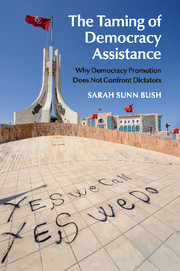Book contents
- Frontmatter
- Contents
- List of figures
- List of tables
- Preface
- List of abbreviations
- Part I Introduction and argument
- 1 Introduction
- 2 The argument: structure, agency, and democracy promotion
- 3 Tame democracy assistance: what it is and why it matters
- Part II Testing the argument
- Part III Conclusions
- Part IV Appendices and references
2 - The argument: structure, agency, and democracy promotion
from Part I - Introduction and argument
Published online by Cambridge University Press: 05 May 2015
- Frontmatter
- Contents
- List of figures
- List of tables
- Preface
- List of abbreviations
- Part I Introduction and argument
- 1 Introduction
- 2 The argument: structure, agency, and democracy promotion
- 3 Tame democracy assistance: what it is and why it matters
- Part II Testing the argument
- Part III Conclusions
- Part IV Appendices and references
Summary
It's frustrating to work in this field because you have your DC funders as stakeholders as well as local stakeholders.
The scattered and diffuse democracy movement of decades past has been transformed into a worldwide industry of sorts, led but not controlled by the United States. The industry has done much good. But it has also put a stamp of legitimacy on Potemkin-village democracies in Cambodia, Egypt, Armenia, and other countries. It has frustrated local democratic activists from Indonesia to Peru, and it has provided autocratic rulers with ammunition to dismiss courageous local democrats as lackeys of foreign powers.
Forty years ago, foreign aid aiming to promote democracy in other countries did not exist. Today, states and international organizations spend billions of dollars each year to promote democratic transition and consolidation abroad. This book seeks to understand how democracy assistance has evolved over that time. It is not the first book to explore the spread of democracy promotion at the end of the twentieth century. Where it parts ways with previous studies, however, is in its focus on how states aid democracy, rather than why and to what effect they do so.
The analysis presented in this book suggests that today many government programs seeking to aid democracy abroad are not designed to confront dictators. Today's democracy-assistance activities emphasize activities, such as in programs supporting local governance and women's representation, that do not threaten the survival of autocrats in at least the short term. They contrast with the more confrontational aid to dissidents, political parties, and trade unions that dominated the early era of democracy assistance. What explains the taming of democracy assistance?
Answering that question matters for several reasons. First, there is concrete evidence that states are likely to adopt the policies, such as gender quotas, and practices, such as election observation, encouraged via democracy promotion. Understanding how states promote democracy thus helps us understand some of the sources of political change in the developing world.
- Type
- Chapter
- Information
- The Taming of Democracy AssistanceWhy Democracy Promotion Does Not Confront Dictators, pp. 22 - 52Publisher: Cambridge University PressPrint publication year: 2015

